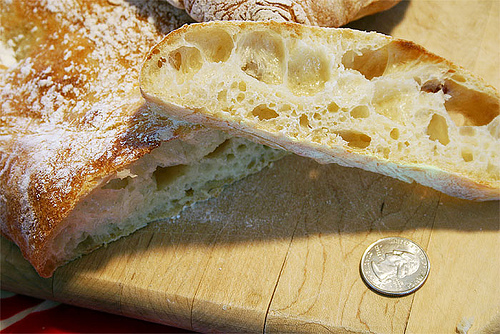Ciabatta Bread 
500g bread flour
475g (~2 cups) water
2 tsp. yeast
15g salt
475g (~2 cups) water
2 tsp. yeast
15g salt
- In Kitchen Aid style mixer: Mix all ingredients roughly till combined with paddle, let it rest for 10 minutes.
- With the paddle (I prefer the hook to prevent the dough from crawling into the guts of the mixer), beat the living hell out of the batter, it will start out like pancake batter but in anywhere from 10 to 30 minutes it will set up and work like a very sticky dough. if it starts climbing too soon, then switch to the hook. You'll know it's done when it separates from the side of the bowl and starts to climb up your hook/paddle and just coming off the bottom of the bowl. I mean this literally about the climbing, i once didn't pay attention and it climbed up my paddle into the greasy inner workings of the mixer. It was not pretty! Anyway, it will definately pass the windowpane test.
- Place into a well oiled container and let it triple! it must triple! For me this takes about 2.5 hours
- Empty on to a floured counter (scrape if you must, however you gotta get the gloop out), cut into 3 or 4 peices. Spray with oil and dust with lots o' flour. Let them proof for about 45 minutes, which gives you enough time to crank that oven up to 260 °C.
- After 45 minutes or so the loaves should be puffy and wobbly, now it's iron fist, velvet glove time. Pick up and stretch into your final ciabatta shape (~10" oblong rectangle) and flip them upside down (this redistributes the bubbles, so you get even bubbles throughout), and onto parchment or a heavily floured peel. Try to do it in one motion and be gentle, it might look like you've ruined them completely, but the oven spring is immense on these things.
- Bake at 260 °C until they are 96 °C in the cnter (about 15-20 minutes), rotating 180 degrees half way through. Some people like to turn the oven down to 232 °C after 10 minutes, but whatever floats your boat. I usually bake in 2 batches.
http://www.thefreshloaf.com/node/2984/jasons-quick-coccodrillo-ciabatta-bread